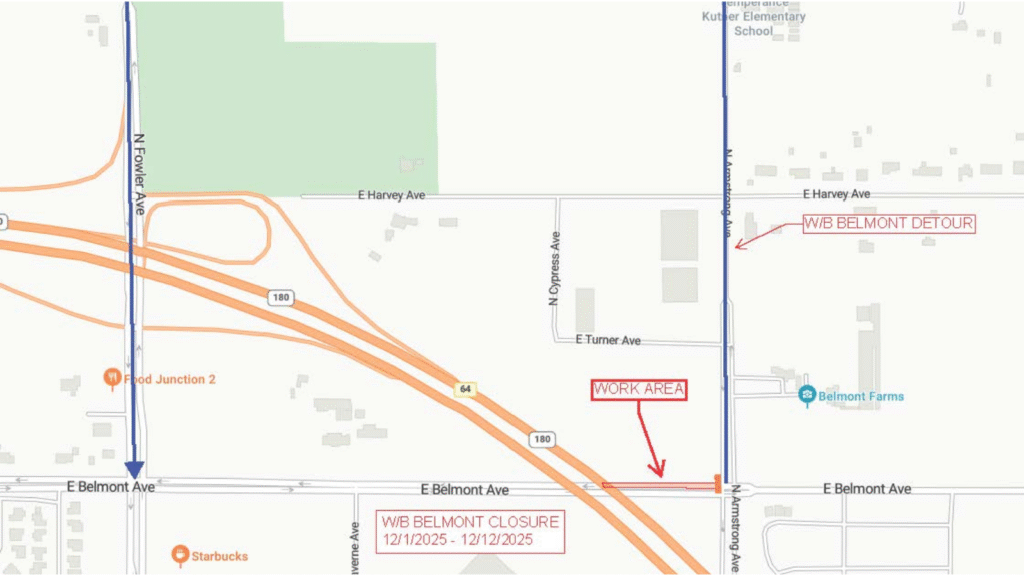Share
|
Getting your Trinity Audio player ready...
|
![]()
■High electric bills consumed 65% of a rural grocery store’s profit last year.
■PG&E rate hikes are pushing struggling businesses towards closure.
■California utilities are seeking higher energy rates to pay for upgrades and safety improvements.

Justo Robles
CalMatters
Twelve years ago, when Tammy and Tim Babcock saw businesses closing in rural northeast California and families moving to bigger cities, they purchased the Big Valley Market in Bieber, with the hope of revitalizing the dying town.
Since then their grocery store has become crucial to the day-to-day lives of residents in the surrounding communities, especially to the 200 or so people living in Bieber, about 250 miles north of Sacramento.
But the store is struggling to survive. Tammy and Tim Babcock blame recent rate increases in their electric bill.
In 2023 the Babcocks paid Pacific Gas & Electric nearly $40,000 for electricity — about two-thirds of the store’s annual profit, Tammy Babcock said. This year rates for businesses their size will grow by 17%, the utility said.
“I called PG&E and I said ‘Are you trying to put us out of business? Are you trying to kill small town America?’” said Tammy Babcock, 62, as she stood in the store she works outside jobs to sustain.

As major California utilities like PG&E seek higher energy rates this year — in part to pay for upgrades and safety improvements — business owners like the Babcocks say that it’s pushing already struggling businesses toward closure. If that happens to the Babcocks’ market, the surrounding neighborhoods and towns would suffer.
The California Public Utilities Commission, which regulates utilities, approved the latest rate hike in November. At the time, the commission said it was to ensure that PG&E maintains a “safe and reliable energy system.” The rate hike, which took effect on Jan. 1, affected tens of thousands of residential and business customers.
For PG&E’s more than 764,000 business owner accounts, rates will rise this year 17 – 21%, depending on size and type of business.
Residential electric rates have nearly doubled in California over the last decade. About 1 in 5 customers, some 2.4 million, are behind in utility bills by an average of $744, said the Public Advocates Office, the consumer arm of the utilities commission.
Small Town Struggles with Rate Hikes
In Bieber, which has very little industry, the median annual household income is about $46,000, according to the U.S. census.
The Babcocks’ market sits below the verdant Big Valley Mountains, which overlook four small towns: Nubieber, Bieber, Lookout and Adin. Fewer than 2,000 people live in this flat farmland.
The store is the main place to buy water, rice, bread and other necessities. The closest Walmart is in Susanville, more than 67 minutes away, and the closest Safeway is in Burney, about 44 minutes away.


In addition to selling groceries, the Babcocks also serve ready-made meals at two tables.
Just before noon in January, six people walked into the Big Valley store and Tim Babcock seated them as his wife went back and forth to the kitchen, serving them tacos.
The regulars, who have known each other for years, watched Fox News on the store TV and discussed community issues.
One of the customers said that if the Big Valley Market were to close, he would have to drive 52 miles east to get milk and other necessities in Alturas. Another customer said she’d have to drive at least 19 miles to get fresh fruit in Fall River Mills.
To generate outside income, the Babcocks operate a hay business and cater weddings, funerals and hospital events, they said.
“We are trying to sustain our business and make a place for the people in the valley so they don’t have to drive back and forth long distances,” Tim Babcock said. “They can’t even afford gas.”
Kathlin Meyer, 73, said she visits the Big Valley Market at least three times a week. It’s the place where she feels most like part of a community, she said, after her move from Fortuna in 2006.
Like Tammy Babcock, Meyer is a cancer survivor. Last year, during Meyer’s chemotherapy, the Big Valley Market delivered food to her house.

“If we close, people have to cross over a mountain, and in the winter the road is covered with ice and snow,” Tammy Babcock said. “We have to help take care of our people, our senior citizens.”
Tim Babcock added that if the electric bills continue to increase, the Big Valley Market would have to close. Tammy Babcock then recited how much they have paid in recent months, holding a list of the store’s electric payments.
In January they paid nearly $3,000 toward the store’s PG&E bill. They made two payments because they couldn’t afford the entire amount immediately. In December, the Babcocks paid nearly $3,000. In November, it was nearly $4,000.
With the approved rate hike, this year the Babcocks expect to pay more than $40,000.
Getting Regulators’ Permission
Republican state Sen. Brian Dahle, who is from Bieber, told CalMatters recently his office receives many calls from people complaining about electric bills and that the state should hold utilities accountable.
PG&E would not make an official available to answer CalMatters’ other questions about the rate hikes but sent a written statement.
“Energy rates were adjusted for all customers to fund investments in the coming years,” the utility said, “to pay for permanent wildfire risk reduction, critical gas and electric safety and reliability work and capacity upgrades to support new business connections and California’s bold clean energy goals.”
Like the Big Valley Market, medium-sized business customers will pay an average of 17% more this year, PG&E said, while small businesses will pay 21% more, agricultural businesses will pay 19% more and large businesses will have a 3.5% increase.
“PG&E is committed to providing ways for its business customers to save energy and money and has a variety of programs and tools available to find the best rate and to save money on their energy bills,” PG&E said. It listed a dozen programs, including monthly “budget billing,” loans to replace equipment, and “economic development rates” for some businesses that are 12% to 25% less.
But PG&E also is seeking another overall rate increase for this year. In June PG&E requested rate hikes to reimburse the utility $688 million for wildfire safety work it had completed.
State regulators earlier this month issued a counter proposal that would allow the utility giant to collect $516 million from customers. A typical residential customer’s bill would go up $4 to $6 a month during the first year, although the lowest-income customers would pay $3 or $4, according to the commission’s proposal.

Mark Toney, executive director of the consumer group the Utility Reform Network (TURN), noted that if this relief is approved, the utilities would immediately start collecting it.
“PG&E shouldn’t automatically be getting this money without a field inspection to make sure they did the right work in the right locations with the right result, and they certainly should not be getting advance payment,” he said.
Mark Toney, Executive Director of TURN
The commission is scheduled to vote on that on March 7.
California Lawmakers’ Objections
Gov. Gavin Newsom appoints and the state Senate confirms all five members of the Public Utilities Commission, where they sit for staggered six-year terms.
Earlier this month, Republican lawmakers introduced a bill that would force state regulators to cut electricity rates across the board by at least 30%.
Assemblymember Joe Patterson, the Republican from Rocklin who introduced the bill, noted existing law gives state regulators authority to fix utility rates and charges at a “just and reasonable” price.
“I went to the CPUC website and I looked at what their mission statement said and, honestly, they don’t even list affordability as their goal,” he said. “How is that possible? I am not saying they don’t think of it when discussing issues, but it should be their priority.”
Lawmakers from both parties, meanwhile, are contesting a separate proposal from the state’s three major investor-owned utilities that would levy fixed rates on residential customers based on their income.

A monthly fixed charge for PG&E’s low-income customers, for instance, would be as low as $15, the utility said, and no more than $30, while moderate-income customers would pay about $51 and customers in the top 25% of earners would pay a fixed $92.
Sen. Scott Wiener, a Democrat from San Francisco, said the utilities’ proposal would place an unacceptable burden on middle class Californians while removing incentives to conserve energy.
“Californians already pay some of the highest electric bills in the nation and should not be forced to arbitrarily pay more to cover for a private utility’s poor business decisions,” Wiener said in an email.
Sen. Scott Wiener
Justin Ong, chief policy advisor at the commission’s Public Advocate’s office, said the average monthly rate for PG&E customers is higher than all other utilities in the state due to the rate hike approved in November.
“We’re still really strong supporters of the fixed charge because it’s one of the only ways to reduce rates,” Ong told CalMatters.
The commissioners who approved the PG&E rate hikes in November will decide on the fixed charge proposal in July. If that plan is authorized, it would be implemented in 2026, Ong said.
‘We Want to Keep Rural America Alive’
A few blocks away from the Big Valley Market, Williams Wells, 55, picked up restaurant food for his mother, whose heart problems prevent her from taking care of herself. Wells said he moved to Beiber from Sacramento to help his 78-year-old mother, but that has become extraordinarily expensive. The breathing machine she needs has been plugged in 24 hours a day for the past six years, he said.
“My mom only receives $400 from Social Security and I work three jobs to be able to take care of her,” Wells said. “I sleep with no heat, and we still pay over $300, and we have seen it go over $700. If it keeps going up, we’d probably be homeless.”

Besides him, the streets in Bieber were empty. Many storefront windows were broken or boarded up. The town of 146 homes was quiet.
Except inside the Big Valley Market, Tammy Babcock was cutting pork into chops while her husband unpacked boxes and filled shelves.
They were preparing for a busy evening. A basketball game was scheduled at the Big Valley High School, a few blocks away. Whatever the Babcocks earned that night would likely go toward the next electricity bill, Tim Babcock said.
“We don’t want to move into the city, we are not that kind of people. But these energy rates ain’t helping, right?” said Tim Babcock.
“It’s a struggle, but we want to keep rural America alive.”
About the Author
Justo Robles was born and raised in Lima, Peru. Since graduating from Rutgers University, he’s worked as a newsroom producer at Spanish-language television networks including Telemundo and Univision, earning Emmy awards in New York and California. As a bilingual reporter, he’s written from South America, Central America and Mexico. His work has been published in The Guardian, NBC News, CBS News, KQED, CNN, El Tímpano and Revista El Malpensante.
Make Your Voice Heard
GV Wire encourages vigorous debate from people and organizations on local, state, and national issues. Submit your op-ed to bmcewen@gvwire.com for consideration.
RELATED TOPICS:
Categories

Gaza Death Toll Tops 70,000, Health Ministry Says


















